
The Virginia Military Institute (VMI) is a public senior military college in Lexington, Virginia. It was founded in 1839 as America's first state military college and is the oldest public senior military college in the United States. In keeping with its founding principles and unlike any other senior military college in the United States, VMI enrolls cadets only and awards bachelor's degrees exclusively. The institute grants degrees in 14 disciplines in engineering, science, and the liberal arts.

The Texas A&M University Corps of Cadets is a student military organization at Texas A&M University. Established with the university in 1876, it is the oldest student organization on campus.

In the United States, an honor society is an organization that recognizes individuals who excel in various domains such as academics, leadership, and other personal achievements, not all of which are based on ranking systems. These societies acknowledge excellence among peers in diverse fields and circumstances. The Order of the Arrow, for example, is the National Honor Society of the Boy Scouts of America. While the term commonly refers to scholastic honor societies, which primarily acknowledge students who excel academically or as leaders among their peers, it also applies to other types of societies.
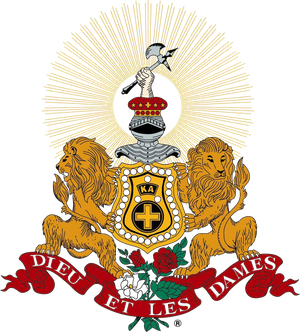
Kappa Alpha Order (ΚΑ), commonly known as Kappa Alpha, KA, or simply The Order, is a social fraternity and a fraternal order founded in 1865 at Washington and Lee University in Lexington, Virginia. As of December 2015, the Kappa Alpha Order lists 133 active chapters, five provisional chapters, and 52 suspended chapters. Along with Alpha Tau Omega and Sigma Nu, the order constitutes the Lexington Triad. Since its establishment in 1865, the Order has initiated more than 150,000 members.

James McIlvaine "Mac" Riley was an American civil engineer and fraternity founder. He worked for the United States Army Corp of Engineers on the Mississippi River and was a surveyor with the City of St. Louis. While in college at the Virginia Military Institute, he was one of the founders of the Sigma Nu fraternity.

The history of Texas A&M University, the first public institution of higher education in Texas, began in 1871, when the Agricultural and Mechanical College of Texas was established as a land-grant college by the Reconstruction-era Texas Legislature. Classes began on October 4, 1876. Although Texas A&M was originally scheduled to be established under the Texas Constitution as a branch of the yet-to-be-created University of Texas, subsequent acts of the Texas Legislature never gave the university any authority over Texas A&M. In 1875, the Legislature separated the administrations of A&M and the University of Texas, which still existed only on paper.

Oakwood Cemetery, originally called City Cemetery, is the oldest city-owned cemetery in Austin, Texas. Situated on a hill just east of I-35 that overlooks downtown Austin, just north of the Swedish Hill Historic District and south of Disch-Falk Field, the once-isolated site is now in the center of the city.
Littleton Waller Tazewell Bradford was a Virginia politician and was a co-founder of Pi Kappa Alpha fraternity.
James Benjamin Sclater Jr. was an American commercial broker and druggist. He was a founder of Pi Kappa Alpha fraternity at the University of Virginia in 1868.
The term Triad is used to designate certain historic groupings of seminal college fraternities in North America.
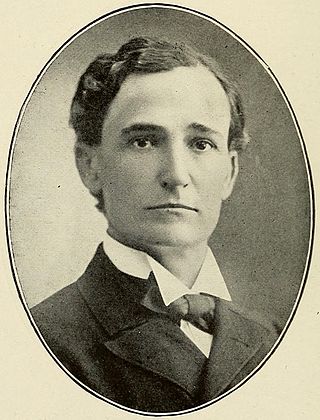
Robert Page Waller Morris was a United States representative from Minnesota and a United States district judge of the United States District Court for the District of Minnesota.
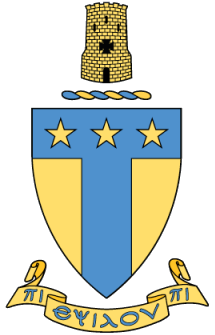
Alpha Tau Omega (ΑΤΩ), commonly known as ATO, is an American social fraternity founded at the Virginia Military Institute in 1865 by Otis Allan Glazebrook. The fraternity has around 250 active and inactive chapters and colonies in the United States and has initiated more than 229,000 members. VMI Cadets are no longer associated with the fraternity. In 1885, the VMI Board of Visitors ruled that cadets could no longer join fraternities based on the belief that allegiance to a fraternal group undermined the cohesiveness of and loyalty to the Corps of Cadets.
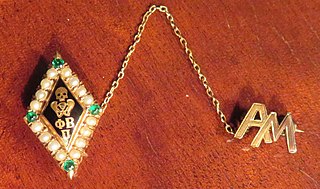
Phi Beta Pi (ΦΒΠ) is an American professional fraternity for medical students that was founded in 1891 at the West Pennsylvania Medical College. Currently, the fraternity operates in Galveston, Texas at the University of Texas Medical Branch at Galveston (UTMB).
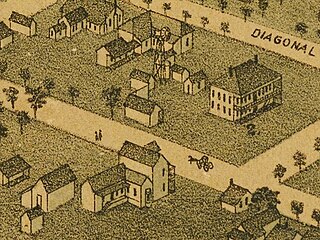
Bastrop Academy, later renamed Bastrop Military Institute, was located in Bastrop, Texas. The institute was moved to Austin in 1870 and renamed to Texas Military Institute.

Edward Magruder Tutwiler was an American industrialist and civil engineer who was a leading businessman in Birmingham, Alabama.

Kappa Sigma Kappa (ΚΣΚ) is the name of three separate college fraternities, sharing a common history and traditions but disconnected by decades and a break in organizational continuity.

Hardaway Hunt Dinwiddie was an educator and a notable figure in the development of Texas higher education. He served as the 4th president of Texas A&M College. He graduated from Virginia Military Institute in 1868. In 1865 while at VMI, he was the second initiate and a charter member of the Alpha Chapter of the Alpha Tau Omega fraternity.
















